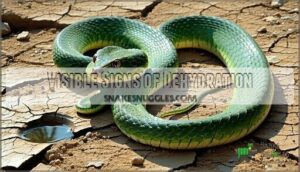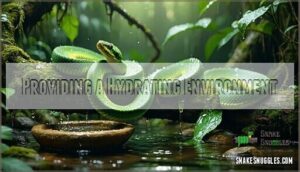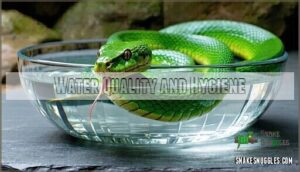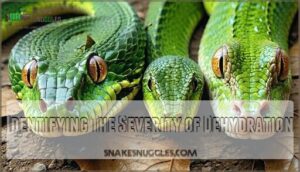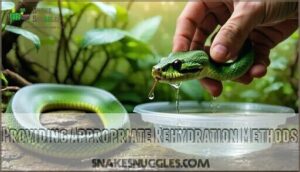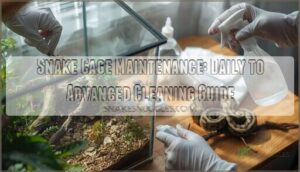This site is supported by our readers. We may earn a commission, at no cost to you, if you purchase through links.
 Proper snake hydration isn’t just about filling a water bowl—it’s about creating the right environment.
Proper snake hydration isn’t just about filling a water bowl—it’s about creating the right environment.
You’ll need to maintain humidity levels between 50-80% depending on your species, provide clean water that’s changed regularly, and watch for dehydration signs like wrinkled skin or stuck shed.
Desert species need humidity spikes during shedding, while tropical snakes require consistently higher moisture.
Your substrate choice matters too, as it affects overall humidity retention.
Think of it like creating a mini ecosystem rather than just dropping in a dish.
Getting the humidity gradient right can make all the difference between a thriving snake and constant health issues.
Table Of Contents
- Key Takeaways
- Why Hydration Matters for Snakes
- Recognizing Dehydration in Snakes
- Providing a Hydrating Environment
- Hydration Techniques for Different Species
- Water Quality and Hygiene
- Hydration Through Food and Environment
- Rehydrating a Dehydrated Snake
- Preventing Dehydration in Snakes
- Managing Humidity and Temperature
- Advanced Hydration Strategies
- Frequently Asked Questions (FAQs)
- How do you hydrate a snake?
- How do you treat dehydration in snakes?
- How do you give a snake water?
- How do you care for a snake in a tub?
- Can you force a snake to drink water?
- Do snakes need water?
- How to add moisture to a snake tank?
- How do you keep snakes hydrated?
- What are the ways to hydrate quickly?
- How do you treat a snake with dehydration?
- Conclusion
Key Takeaways
- Monitor your snake’s physical signs daily – you’ll spot dehydration early by checking for sunken eyes, poor skin elasticity when gently pinched, and sticky mouth tissue that doesn’t snap back quickly.
- Create species-specific humidity zones – tropical snakes need 70-80% humidity with frequent misting, while desert species thrive at 30-50% humidity with minimal moisture and shallow water dishes.
- Maintain clean water and proper substrate choices – change water every 2-3 days using reptile-safe disinfectants, and choose moisture-retaining substrates like cypress mulch for consistent hydration.
- Use multiple hydration methods beyond water bowls – provide lukewarm soaks for dehydrated snakes, create humid hides with damp moss, and remember that prey items contribute significant moisture to your snake’s diet.
Why Hydration Matters for Snakes
Your snake’s body is over 60% water, making proper hydration absolutely essential for their survival and wellbeing.
Proper hydration keeps your snake’s body functioning like a well-oiled machine – without it, everything breaks down fast.
Without enough water, your serpent can’t digest food properly, shed their skin completely, or even regulate their body temperature effectively.
Physiological Needs and Requirements
Your snake’s body operates like a finely tuned biological machine that’s approximately 60% water. Without proper hydration, those Metabolic Processes slow down dramatically, affecting everything from Cellular Hydration to Organ Functions.
Think of water as your snake’s internal maintenance crew – it keeps physiological functions running smoothly and maintains healthy Muscle Tone.
Here’s what proper snake hydration needs support:
- Cellular Hydration guarantees your snakes cells function properly and communicate effectively
- Scale Health depends on adequate moisture to maintain flexibility and prevent cracking
- Your snakes metabolism relies on water for temperature regulation and snakes digestive system preparation
When dehydration strikes, it’s like your snake’s biological factory starts shutting down departments one by one, making hydration absolutely vital for survival.
Importance of Water for Digestion
Water turns your snake into a digestion efficiency machine! Without proper hydration, nutrient absorption slows down and waste elimination becomes problematic.
Here’s how water intake powers your snake’s metabolic processes:
| Digestive Function | Water’s Role |
|---|---|
| Enzyme activation | Kickstarts breakdown |
| Food processing | Lubricates movement |
| Nutrient transport | Carries vitamins |
| Gut health maintenance | Prevents constipation |
Your snake’s digestive system relies on H2O for smooth snake digestion and healthy snake metabolism.
Role of Hydration in Shedding and Skin Health
For your snake, proper hydration transforms shedding from a stressful struggle into a smooth, natural process.
Proper hydration turns your snake’s shed from a nightmare into nature’s perfect reveal.
When your serpent’s skin stays well-hydrated, the shedding process becomes effortless – like peeling off a sock that slides right off. Adequate snake hydration guarantees healthy skin elasticity and scale flexibility throughout each shedding cycle.
Here’s how proper hydration supports successful snake shedding:
- Maintains scale flexibility – preventing dysecdysis and stuck shed patches
- Preserves skin elasticity – allowing old skin to separate cleanly
- Reduces shedding frequency complications – guaranteeing complete, healthy molts
Think of snake skin health like a well-oiled machine. Without enough moisture, your snake’s skin becomes brittle and prone to incomplete sheds.
Effects of Hydration on Temperature Regulation
Through your snake’s internal cooling system, proper hydration enables effective evaporative cooling and thermoregulation.
When water balance drops, your serpent can’t manage body heat properly, leading to dangerous heat stress.
This thermoregulation impact forces dehydrated snakes to seek water bowls desperately.
Without adequate snake hydration, their cooling mechanisms fail, creating serious dehydration risks that compromise their entire thermoregulation game.
Recognizing Dehydration in Snakes
Spotting a dehydrated snake isn’t always obvious, but knowing the warning signs can save your pet’s life.
You’ll need to watch for both physical symptoms and changes in behavior that signal your snake needs immediate attention.
Symptoms and Warning Signs
Knowing when your snake needs help starts with recognizing the telltale dehydration signs.
Your snake’s body will send clear signals when water levels drop dangerously low.
Here are the key snake dehydration symptoms to watch for:
- Sunken Eyes – They’ll look deflated and sit deeper in the sockets
- Poor Skin Elasticity – When gently pinched, skin stays tented instead of snapping back
- Flaky Scales – Dry, dull scales that lack their normal shine
- Sticky Mouth – Tacky saliva and dry mucous membranes
- Lethargy Signs – Unusual hiding, decreased appetite, and reduced activity
These signs of dehydration often appear together during snake dehydration assessment, making them easier to spot once you know what you’re looking for.
Behavioral Changes and Lethargy
Beyond those telltale physical signs, your snake’s personality might seem completely different when dehydration sets in. Think of it like your pet having an off day – except this "off day" could signal something serious. Dehydrated snakes often become couch potatoes, showing clear Activity Changes and Lethargy Causes that are hard to miss.
Snake Depression and Appetite Loss go hand-in-hand with dehydration, creating a concerning cycle. Here’s what snake dehydration symptoms look like behaviorally:
- Your normally curious snake stops exploring and tongue-flicking
- Hiding Behavior increases – they’ll retreat to dark corners constantly
- Feeding time becomes a struggle with complete food refusal
- Handling sessions reveal a limp, unresponsive snake
- Their usual defensive postures disappear entirely
Recognizing these signs of dehydration early helps prevent serious health issues. Snake behavior changes often appear before visible symptoms, making behavioral monitoring your first line of defense in snake hydration tips. Lethargy and appetite loss can also point to underlying snake diseases, so it’s essential to monitor your snake.
Visible Signs of Dehydration
Your snake’s physical appearance reveals critical dehydration in snakes through several unmistakable signs.
Watch for sunken eyes that look hollow, wrinkled skin lacking normal skin elasticity when gently pinched, and dry, flaky scale appearance indicating shedding problems.
Check mouth tissue – it shouldn’t feel sticky or dry, which signals reduced saliva production alongside lethargy signs.
Sunken eyes
Wrinkled skin
Dry, flaky scales
These snake symptoms demand immediate attention to prevent serious health complications.
Providing a Hydrating Environment
Creating the right environment is your snake’s first line of defense against dehydration.
You’ll need to balance humidity, temperature, and substrate choices to build a habitat that naturally supports proper hydration levels, which includes considering the right balance to ensure your snake’s health.
Maintaining Optimal Humidity and Temperature
Spotting the warning signs puts you ahead of the game, but prevention beats treatment every time.
Your snake’s comfort zone depends on nailing the humidity and temperature sweet spots. Here’s your game plan for Microclimate Creation:
- Humidity Monitoring with hygrometers guarantees ideal humidity for snake enclosure stays between 50-70%
- Temperature Gradients let your snake choose its perfect ball python temperature humidity zone
- Enclosure Ventilation prevents stagnant air while maintaining those perfect humidity levels
Seasonal Adjustments keep your setup working year-round! A valuable tool for this is a reliable snake hygrometer.
Choosing The Right Substrate and Decor
The right substrate choices can transform your snake enclosure into a humidity paradise.
Coconut husk and cypress mulch excel at substrate moisture retention, maintaining humidity levels without creating soggy conditions.
These substrates support your snake’s burrowing needs while offering cleaning ease during maintenance.
Some substrates, like aspen, help prevent bacterial and odor issues by providing a clean environment.
Choose decor materials like smooth rocks and sturdy branches for hiding spots that won’t harbor bacteria.
Your ideal humidity for snake enclosure depends on selecting materials that work together, creating the perfect balance between moisture retention and cleanliness for your serpent’s comfort.
The selection of the right materials is crucial for maintaining a healthy environment, and by following these guidelines, you can create an ideal space for your snake.
Creating a Hydrating Microclimate
Creating a hydrating microclimate is essential for your snake’s wellbeing. You’ll design specific zones within your snake enclosure that offer varying humidity levels and moisture access. This approach gives your serpent choices – like having different rooms in a house for different needs.
Here’s how to build your snake’s personal humidity haven:
- Set up humidity gradients by misting one side more heavily than the other
- Install water features like shallow dishes or dripping systems for ambient moisture
- Create ventilation importance balance with strategic air flow that prevents stagnation
Use moisture-retaining substrate selection like cypress mulch in humid zones. Your snake misting routine should focus on specific areas rather than the entire enclosure. Monitor your reptile hydration setup with hygrometers, and adjust your misting systems based on your snake’s behavior and shedding cycles.
Hydration Techniques for Different Species
Not all snakes drink water the same way, and understanding your species’ natural habitat is key to keeping them properly hydrated.
Whether you’re caring for a humidity-loving rainforest python or a desert-dwelling sand boa, tailoring your approach to their specific needs makes all the difference in their health and happiness.
Tropical Snakes and High Humidity
Tropical species need serious humidity control to stay healthy and happy.
You’ll want to maintain 70-80% humidity using misting systems and large water features that double as soaking spots.
Arboreal hydration matters too—tree-dwelling snakes love when you mist their branches and leaves.
Use moisture-retaining substrates like cypress mulch, but watch out for mold prevention by ensuring good ventilation.
Your humid environment should feel like a rainforest, not a swamp.
Daily misting keeps things perfect, and a reliable hygrometer helps you nail those humidity levels.
Remember, these snake species evolved in steamy jungles, so proper snake hydration means recreating that tropical paradise in their enclosure.
Higher humidity is key because it increases snake activity.
Desert Snakes and Water Conservation
Desert dwellers excel at conserving precious water through remarkable xeric adaptations. These snake species use nocturnal behavior and burrowing benefits to minimize water loss while maximizing water acquisition from limited resources.
You’ll need shallow dishes and minimal misting – their specialized scales actually harvest rainwater. Even desert species require consistent access to water sources for proper snake hydration and healthy snake drinking habits.
Many species have developed key behavioral adaptations for desert survival, which is crucial for their existence in such harsh environments, making proper snake hydration essential.
Species-Specific Hydration Needs
Beyond desert species, each snake has unique water needs like a personalized hydration recipe. Boas and pythons showcase natural soaking behavior, requiring spacious bowls for submersion. Tree-dwelling snakes thrive with arboreal hydration through misting systems that mimic their natural habitat.
Here’s how to match your snake’s needs:
- Semiaquatic species need large water dishes and higher humidity for proper habitat mimicry
- Desert species require minimal misting but benefit from dietary moisture through prey items
- Tropical snakes demand consistent humidity and frequent water access for healthy shedding
Understanding different snake species requirements guarantees your pet stays properly hydrated and healthy.
Water Quality and Hygiene
You’ll want to keep your snake’s water spotless since dirty bowls can harbor nasty bacteria and parasites that’ll make your pet sick.
Clean water isn’t just about drinking—it’s essential for proper shedding, healthy skin, and good digestion.
Importance of Clean Water for Snakes
You know that sparkling water bowl isn’t just for show – it’s your snake’s ticket to clean water and peak snake health.
Dirty water becomes a breeding ground for waterborne diseases, turning your pet’s drink into a risky cocktail of bacteria and parasites that can wreck their immune system.
Quality bowl material safety matters too – choose non-porous surfaces that won’t harbor nasties.
While fancy filtration systems aren’t necessary, consistent cleaning frequency keeps problems at bay.
Skip unnecessary water additives and focus on maintaining excellent water quality through regular maintenance.
Your snake’s snake water bowl deserves the same attention you’d give your own drinking glass.
Preventing Bacterial and Parasite Growth
Your snake’s water bowl can easily turn into a bacteria buffet if you’re not careful. Dirty water harbors harmful organisms that cause infections, respiratory issues, and serious health problems for your slithery friend.
Here’s what happens when water gets contaminated:
- Bacterial blooms multiply rapidly in warm, stagnant water
- Parasites thrive in dirty conditions, threatening your snake’s gut health
- Foul odors develop, making the entire enclosure smell terrible
- Skin infections emerge from prolonged contact with contaminated water
Bowl disinfection using reptile-safe disinfectant prevents these nasty surprises. Water filtration systems help maintain clean conditions between changes.
Always use safe conditioners when treating tap water, and make immediate changes if water looks cloudy or smells off. Regular maintenance keeps your snake’s water quality pristine and prevents water contamination from ruining their health.
Regular Water Changes and Cleaning
Your snake water dish needs regular attention to stay healthy. Change the water every 2-3 days and scrub the snake water bowl cleaning routine with reptile-safe disinfectants.
Bowl material matters – choose heavy, stable options that resist bacteria. Use dechlorinated water source or bottled spring water for best snake water quality.
For specialized products, consider exploring options for maintaining ideal conditions. Cleaning frequency increases in warmer conditions or if your snake soaks often.
Disinfectant choices should be reptile-specific to avoid harmful residues. Some keepers add filtration systems for consistent quality, though regular water changes remain essential for superior snake tank cleaning practices.
Hydration Through Food and Environment
Your snake doesn’t just drink water from its bowl – it also gets hydration from its food and surroundings.
Understanding how snakes absorb moisture through their prey and environment helps you create a complete hydration strategy that mimics their natural habits, including a plan that considers how they absorb moisture through their environment.
Prey Items and Water Content
Beyond the water bowl, your snake’s meals deliver serious hydration. Fresh prey packs impressive Prey Moisture content that supports healthy snake hydration. Frozen vs Live options both retain water, though fresh prey typically offers higher moisture levels.
Consider these hydration-packed options:
- Mice: 70% water content for ideal reptile nutrition
- Rats: 65-70% moisture-rich snake meals
- Chicks: 75% water content
Dietary Variety in Prey Size enhances your snake’s overall hydration strategy naturally.
Absorbing Moisture From Environment
Your snake’s like a living sponge, constantly soaking up Environmental Moisture from its surroundings. This natural behavior helps maintain proper snake hydration even without direct drinking.
| Species Type | Preferred Humidity | Substrate Hydration Method |
|---|---|---|
| Tropical | 70-80% | Cypress mulch, moss |
| Desert | 30-50% | Sand, paper towels |
| Temperate | 50-60% | Aspen shavings |
| Arboreal | 60-80% | Coconut fiber |
| Semi-aquatic | 80-90% | Sphagnum moss |
You’ll notice Natural Behaviors like pressing against damp surfaces or hiding in humid spots. Misting Benefits include increased snake humidity and drinking opportunities, while Rain Simulation mimics their wild snake environment. These snake hydration tips help your serpent thrive naturally.
Specialized Hydration Techniques in Species
When your snake species needs specialized hydration techniques, understanding their natural behaviors makes all the difference. Arboreal snakes prefer misting systems that create water droplets on leaves, mimicking rainforest conditions. Desert adaptations include coiling behaviors that channel rainwater directly to their mouths. Aquatic snakes require fresh water access since they refuse saltwater despite living near it.
These snake hydration methods vary dramatically between species. Here are three key snake hydration techniques:
- Arboreal misting sessions for tree-dwelling species that ignore water bowls
- Desert adaptations using specialized body positioning during rare rainfall
- Brumation hydration adjustments for seasonal dormancy periods
Shedding assistance often requires increased humidity regardless of species. Monitor your snake’s natural drinking patterns and adjust accordingly. When standard snake veterinary care methods fail, species-specific approaches guarantee peak snake species hydration success.
Rehydrating a Dehydrated Snake
When you spot the signs of dehydration in your snake, you’ll need to act quickly but carefully to restore their health.
The severity of their condition determines whether you can handle rehydration at home or need professional veterinary care right away, which is crucial for quickly restoring their health.
Identifying The Severity of Dehydration
Assess your snake’s condition carefully when dehydration strikes. Look for sunken eyes and perform the skin pinch test—healthy skin snaps back instantly. Check mucous membranes for dryness and observe behavioral cues like lethargy.
Early dehydration signs include subtle changes in hydration indicators, while severe cases show obvious distress requiring immediate attention.
| Dehydration Level | Key Indicators |
|---|---|
| Mild | Slightly sunken eyes, reduced skin elasticity |
| Moderate | Wrinkled scales, sticky mucous membranes |
| Severe | Deep sunken eyes, poor scale condition |
| Critical | Extreme lethargy, advanced dehydration symptoms |
Providing Appropriate Rehydration Methods
If your snake’s looking parched, try these rehydration techniques.
Start with fresh water in a shallow dish and a little Snout Dripping to spark interest.
Water Soaking works wonders—let them chill in lukewarm water for 15-20 minutes.
Electrolyte Soaks or Humidity Boxes can boost snake hydration fast.
Electrolyte solutions are great for snake dehydration treatment, and keeping things moist keeps those scales shiny!
Veterinary Intervention for Severe Cases
When home treatment isn’t enough, professional help becomes your snake’s lifeline. Veterinarians can administer specialized fluid therapy that goes beyond basic soaking.
- Coelomic fluids delivered directly into the body cavity for rapid rehydration
- Subcutaneous injections provide controlled fluid delivery under the skin
- Assisted feeding helps maintain nutrition during recovery
Your snake veterinarian might also recommend antibiotic support if infections complicate the dehydration. Don’t wait – severe cases need immediate parenteral fluid treatment.
Preventing Dehydration in Snakes
The best defense against dehydration is a strong offense – consistent care and monitoring keep your snake healthy and hydrated year-round.
By maintaining proper husbandry practices and catching early warning signs, you’ll prevent most hydration issues before they start, which is a key part of a healthy routine.
Proper Husbandry and Enclosure Management
Creating your snake’s perfect home is like designing a five-star hotel for scales.
Proper snake enclosure management prevents dehydration through three key elements:
- Enclosure Size: Larger spaces accommodate bigger snake water bowls and better thermal gradient distribution
- Substrate Choice: Moisture-retaining materials like cypress mulch support snake hydration naturally
- Ventilation Needs: Balanced airflow prevents stagnant humidity while maintaining ideal moisture levels
Smart hides & decor placement creates microclimates where your snake can self-regulate.
Maintaining ideal humidity levels is also vital for preventing shedding problems and respiratory issues.
Quality reptile care means monitoring these fundamentals daily—your snake’s health depends on this foundation.
Monitoring Health and Detecting Early Warning Signs
Keep tabs on your snake’s hydration checks – their snake health indicators tell the whole story.
Watch for early symptoms like sunken eyes or sticky mouth tissue. Your snakes body tells tales through dull skin and incomplete sheds.
Regular behavior monitoring reveals lethargy or appetite loss. Test skin elasticity by gently pinching – healthy skin snaps back quickly.
If warning signs persist beyond 48 hours, schedule a veterinary consult immediately.
Preventative Measures and Husbandry Practices
Smart habits keep your snake’s hydration on point! Enclosure Maintenance isn’t just about looks—it’s about creating the perfect snake spa.
Choose substrates that hold moisture without becoming swampy. Regular Hydration Monitoring catches problems early, while Scheduled Cleaning keeps everything fresh.
Here are three game-changing preventative measures:
- Water Access variety – Provide multiple hydration options like bowls, misters, and humidity hides
- Substrate Choice matters – Use moisture-retentive materials like cypress mulch or coconut husk
- Daily checks – Monitor snake water quality, bowl cleanliness, and your snake’s hydration needs consistently
Managing Humidity and Temperature
Getting your snake’s humidity and temperature just right is like finding the perfect balance for their health and happiness.
When these two work together properly, your snake stays hydrated naturally and feels comfortable in their home.
Measuring and Maintaining Optimal Humidity
Looking for that perfect humidity balance? You’ll want to grab a reliable hygrometer and place it strategically for accurate humidity monitoring.
Most snakes thrive in that 50-70% sweet spot, but don’t forget seasonal adjustments when your heating kicks in.
| Species Type | Ideal Humidity | Hygrometer Placement | Ventilation Balance |
|---|---|---|---|
| Tropical | 60-80% | Cool side, mid-level | High air exchange |
| Desert | 30-50% | Warm side, low | Moderate airflow |
| Temperate | 50-70% | Center, multiple spots | Balanced circulation |
Your substrate moisture plays a huge role too – coconut husk and cypress mulch are moisture-retaining champions. Keep one eye on those readings and adjust your misting schedule accordingly. Remember, snake hydration depends on getting this humidity management just right!
Temperature Regulation and Hydration
Your snake’s thermoregulation game directly affects its hydration needs.
When snake temperature rises, water loss increases through evaporative cooling mechanisms.
Your serpent’s behavioral thermoregulation includes seeking moisture when body heat climbs.
Here’s how temperature impacts snake hydration:
- Monitor humidity closely during heating cycles
- Adjust substrate moisture based on temperature changes
- Provide shallow baths during warmer periods
- Use substrates retaining moisture without becoming waterlogged
Understanding these hydration mechanisms helps your snake’s internal cooling system work efficiently.
Temperature fluctuations trigger different water requirements, making consistent monitoring essential for ideal health.
Creating a Hydrating Gradient
Building the perfect hydrating gradient is like creating a moisture highway for your snake. Place your snake water bowl on the cooler side where humidity naturally pools. Layer moisture-retaining substrates like coconut husk near the water source, shifting to drier options toward the basking spot.
| Zone | Humidity Levels | Substrate Choice |
|---|---|---|
| Cool/Wet | 70-80% | Coconut husk, cypress mulch |
| Mid-Range | 60-70% | Mixed substrates |
| Warm/Dry | 50-60% | Aspen, paper towels |
| Basking | 40-50% | Sand, tile |
This thermal gradient creates microclimate options where your snake can self-regulate. Smart ventilation needs prevent stagnant air while maintaining the gradient. Your snake becomes the master of its own snake humidity management!
Advanced Hydration Strategies
When basic hydration methods aren’t enough, you’ll need more sophisticated techniques to keep your snake properly moisturized.
Advanced strategies like misting systems, humidity chambers, and species-specific approaches can make the difference between a thriving serpent and one struggling with dehydration issues.
Misting and Rain Chambers
Moisture mastery transforms your snake’s environment into a humidity haven. Misting recreates natural rainfall patterns, while rain chambers offer therapeutic hydration sessions.
Here’s why both matter:
- Species preferences – Tropical snakes crave daily misting, desert species need minimal moisture
- Natural stimulation – Triggers drinking behaviors and promotes healthy shedding cycles
- System maintenance – Clean equipment prevents bacterial growth and guarantees consistent humidity levels
Consider using a complete misting system to automate humidity control.
Humidity Hides and Microclimates
Beyond misting and rain chambers, you can create specialized humid hides that work like personal snake spas. Think of them as moisture-packed retreats where your serpent can chill and recharge.
Hide Materials matter. Use plastic containers with damp sphagnum moss, paper towels, or coconut fiber. Cut an entrance hole that’s snug but comfortable for your snake’s body size.
Microclimate Design focuses on Humidity Levels reaching 80-100% inside the hide while maintaining your snake enclosure’s normal levels elsewhere. This gradient lets your snake choose its comfort zone.
Here’s your setup checklist for ideal snake hydration and snake shedding:
- Position strategically: Place on the warm side for better moisture retention
- Monitor regularly: Check substrate moisture weekly during snake care routines
- Species-specific sizing: Match hide dimensions to your snake’s Species Needs
Follow these Maintenance Tips: replace substrate when it starts decomposing and clean the humid hide monthly with reptile-safe disinfectant.
Advanced Hydration Techniques for Specific Species
Certain species demand customized snake hydration approaches that go beyond basic water bowls.
Arboreal misting systems work wonders for tree-dwelling species like emerald tree boas, who prefer droplets over standing water.
Desert adaptations require minimal humidity with shallow dishes and light daily misting to simulate dew.
Semi-aquatic hydration means deeper water sources for species like cottonmouths.
| Species Type | Hydration Method |
|---|---|
| Arboreal | Misting systems, rain chambers |
| Desert | Shallow dishes, dew simulation |
| Semi-aquatic | Deep water bowls with ramps |
| Tropical | High humidity, large soaking areas |
| Burrowing | Humid substrate microclimates |
Understanding snake hydration needs prevents snake hydration problems and guarantees the best snake hydration status.
Frequently Asked Questions (FAQs)
How do you hydrate a snake?
You’ll provide fresh water daily in a shallow bowl, maintain proper humidity (50-70%), and mist tropical species. For dehydrated snakes, offer lukewarm soaks for 15-20 minutes.
How do you treat dehydration in snakes?
Soak your snake in lukewarm water (85-90°F) for 15-30 minutes daily.
Increase enclosure humidity with damp moss. Provide fresh water and check temperature settings.
Seek vet care if symptoms persist.
How do you give a snake water?
Picture a parched desert traveler finding an oasis – that’s your snake discovering fresh water.
You’ll provide clean water in a shallow, stable bowl that’s large enough for soaking but easy to access for drinking.
How do you care for a snake in a tub?
Keep your tub setup clean with proper ventilation, secure lid, and appropriate substrate.
Maintain temperature gradients using under-tank heaters.
Provide fresh water, hiding spots, and monitor humidity levels regularly for snake health.
Can you force a snake to drink water?
You can’t force snakes to drink, but you can encourage it.
Gently drip lukewarm water on their snout to trigger drinking.
Providing soaking opportunities helps too, since they’ll often drink while soaking.
Do snakes need water?
Water isn’t just nice-to-have for snakes—it’s literally life or death. Your snake’s body is over 60% water, so they need it for digestion, shedding, breathing, and staying healthy.
How to add moisture to a snake tank?
You can boost humidity by misting the enclosure, adding a humidity box with damp moss, using moisture-retaining substrates like cypress mulch, or placing a larger water bowl for soaking.
How do you keep snakes hydrated?
Picture Sarah noticing her ball python’s sunken eyes after forgetting to refill its water bowl for days.
You’ll keep snakes hydrated by providing fresh water daily, maintaining proper humidity levels, and offering lukewarm soaks when needed.
This approach ensures the snakes remain healthy by covering the essential aspects of their hydration needs.
What are the ways to hydrate quickly?
Try lukewarm soaks for 15-30 minutes, increase humidity with damp moss, gently drip water on their snout, or use electrolyte solutions. Seek vet help if symptoms persist.
How do you treat a snake with dehydration?
First, provide lukewarm water soaks for 15-30 minutes daily.
Increase enclosure humidity with damp moss or misting.
Offer fresh water constantly and gently drip water on their snout to encourage drinking.
Conclusion
Mastering these snake hydration tips transforms novice keepers into confident caregivers.
You’ve learned to spot dehydration early, create proper humidity gradients, and maintain species-specific environments.
Remember, it’s not just about water bowls—it’s about building that perfect mini ecosystem.
Your snake’s health depends on consistent monitoring and adjustments.
When you get the humidity right, you’ll see improved shedding, better appetite, and overall well-being.
These practices become second nature with time.
- https://pmc.ncbi.nlm.nih.gov/articles/PMC10363785/
- https://redinational.com/can-weather-conditions-affect-snake-activity-in-your-area/
- https://journals.biologists.com/jeb/article/228/2/JEB247964/365512/Flexibility-of-cutaneous-evaporative-water-loss-in
- https://www.evolutionreptiles.co.uk/blog/how-to-lower-humidity-in-vivarium/
- https://www.gvi.co.uk/blog/adaptations-of-desert-wildlife-in-the-namib/



